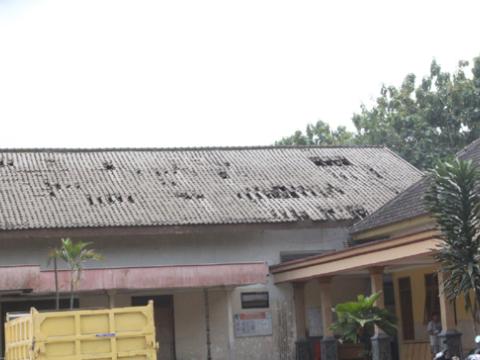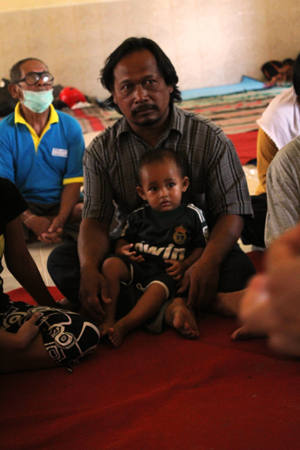The Yearning to Return Home

Kediri, East Java, Indonesia -- Sumber Agung village administrative office became a new “home” for 65 families who fled from their villages due to Mount Kelud eruption late on February 13. Almost 400 people arrived there on that night. Their world stopped while the ash and rock poured from the sky.
Thankfully, the mountain has calmed down, although the authorities are still reminding the evacuees to keep away from the danger zone of 10 km from the crater.
Some of the displaced people already returned home, but some whose houses are so close to the crater must stay at the shelter.
Mujiono, 46, is one of those still forced to stay at the shelter in Sumber Agung town. Even though he has to stay at the shelter, he is always smiling and glad to share his stories.
“I am aware of Mount Kelud alert status that day. That’s why, most of the males in my village gathered at my house that night. We didn’t sleep, just chatted and drink tea while staying on guard for updates. Once we find out the need to evacuate, we ran at 9.30 PM. Thankfully, I already prepared a bag full of clothes and personal care just in case anything happens. The falling rocks are this big,” said Mujiono showing off his fist in front of me.
“We are grateful for the tarpaulins and plastic mats from World Vision. Please send my gratitude to all your friends who have given all these (family kit) packages. Thank you so much,” Mujiono added.
Mujiono choose Sumber Agung evacuation center as his family’s temporary shelter because it is better organized, cleaner, and comfortable according to him. He could choose closer shelters from his village in Mulyorejo, but most of them were already full and less comfortable.
“I left my cattle and chickens at home. I need to go back there to feed them and to clean the roofs too. I don’t want my house to collapse,” Mujiono said. The ash on the rooftops in the neighborhood were very thick and scores of roofs have collapsed.
“There is an open area between my kitchen and the main room. It is now filled with thick ash. I believe that one truck will not be able to carry all the ash away- It’s too much,” said a father of two whose house is located some 10 km from Kelud’s crater.
Mujiono was quick to evacuate. He, his wife, and two children used two motorbikes to get to Sumber Agung shelter. His relative who works at the transportation office called him for an early warning. Along the way on his motor bike, Mujiono’s family shouted the same warning to their neighbors, asking them to rush away to safer shelters.
Monday morning, 17 February 2014, Mujiono was still at the evacuation center. He already spent four nights there, but made a quick trip back to his house to clean up the ash and feed his cattle. Like Mujiono, many other men did the same thing.
“I can’t live there at the moment, even if the government declares it safe to get back there. We couldn’t just come back home immediately with all the ash blanketing the village. We will need to stay at this shelter for a while until we can completely clean and fix all damage at home.”
“We are grateful for the tarpaulins and plastic mats from World Vision. Please send my gratitude to all your friends who have given all these (family kit) packages. Thank you so much,” Mujiono added.
Tria, 36, also expressed similar gratitude. She received a family kit at the Segaran Village evacuation center.
“I am so happy because World Vision handed over the aid directly to each of us. This is the first time we received this kind of items. On Friday, our shelter received pillows and bed sheets, but they went directly to the storage room. I don’t know when they will be given to us.”
“Our neighborhood only had 15 minutes to prepare for the evacuation before Mount Kelud erupted. I didn’t bring anything when I left home. The sound of the eruption really scared me,” said Tria, whose six-year-old son clung to her feet as she spoke.
Food and non-food items are still needed for these survivors. The Mount Kelud danger zone had been slightly reduced and to return home is what the families really want. But, with all the ash still covering their houses and villages -- and also the possibility of fresh eruptions -- it might still take some time for them to be able to resume their normal lives.
Photos and story by Shintya Kurniawan, Media Relations World Vision Indonesia | Edited by Hendro Suwito, Senior Editor World Vision Indonesia
